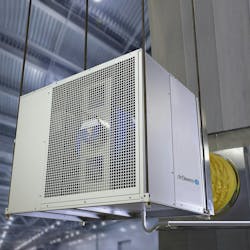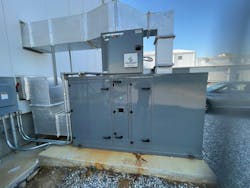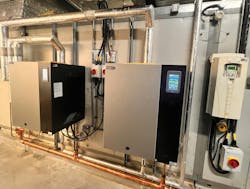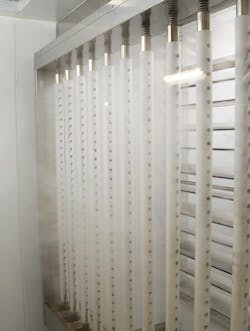Trends in Humidification and Dehumidification Technologies for Commercial Buildings
As commercial building standards evolve to prioritize occupant comfort, energy efficiency, and indoor air quality, humidification and dehumidification technologies are becoming increasingly important. HVAC contractors are seeing growing demand for systems that offer precise moisture control, especially in health care and data center applications.
“The biggest trend is the shift toward what we refer to as adiabatic humidification and electric generation of steam,” says Matt Nowak, North American director – Steam and Condensate for Armstrong International. “Due to decarbonization, fewer facilities are utilizing building steam or a boiler, and so they're looking for other ways to supply humidification in those buildings and facilities.”
David Baird, applications engineer at DriSteem, agrees, noting that commercial and industrial sectors are leaning more heavily into prioritizing energy efficiency and precise control in their equipment choices.
Buildings are increasingly adopting low-energy humidification technologies and turning to adiabatic solutions, which utilize evaporative cooling to increase relative humidity levels while lowering HVAC cooling loads,” Baird says. “High-efficiency steam systems are also gaining traction, offering accurate humidity control with reduced energy consumption, making them ideal for facilities pursuing sustainability and cost-reduction goals.”
At the same time, dehumidification is becoming increasingly important, Baird adds — especially in climates with high moisture levels or facilities requiring strict environmental control. “Energy-efficient dehumidification solutions help maintain stable indoor conditions, protect building materials and equipment, and enhance occupant comfort — all while minimizing operating costs.”
These trends are driven by regulatory pressures, climate change, and economic considerations, according to Baird, who points to organizations such as ASHRAE, WELL, and LEED that are raising the bar for overall indoor air quality (IAQ) and energy-efficient design.
“Increasingly unpredictable weather patterns, leading to more extreme conditions, are making responsive and reliable humidity control more critical than ever,” he says.
David Schurk, DES, CEM, LEED-AP, CDSM, CWEP, CIAQM, SFP, national sales manager for Innovative Air Technologies, highlights the proliferation of lithium battery manufacturing as a key driver of dehumidification market growth.
“Those environments require incredibly low relative humidities and dew point temperatures, so they require dehumidification systems such as solid desiccant,” he explains. “Dehumidification is capable of drying the air down to perhaps a negative 80-degree dew point and maintaining relative humidities in the space at 1%. This is required in those environments because lithium will react violently with moisture in the air and combust — it's a safety issue.”
Another market driving dehumidification growth is data centers, Schurk adds. “They’re looking at lower indoor relative humidities to assist in the comfort of the workers in the server aisles. That’s driving dehumidification trends to provide drier environments, and that requires dehumidification equipment that is capable of more stringent, lower dew point temperatures and lower relative humidity.
“We're also seeing a lot of hospital operating rooms that have been ailing or failing for decades, and they're retrofitting their existing systems with typically solid desiccant dehumidification to obtain lower relative humidities in the space,” he continues. “Then, we're seeing those that have been successful in the retrofits, applying it to their new projects and new builds in the same fashion. We're finally seeing that vertical market segment understand some of the issues they’ve had in the past can actually be solved if they do it right and apply the right equipment.”
Climate and Sustainability
Rising global temperatures and shifting weather patterns have led to more frequent and extreme humidity fluctuations. Commercial buildings now face greater challenges in maintaining IAQ, comfort, and energy efficiency, especially in regions experiencing hotter, more humid conditions for longer periods of time.
“Climate change has made seasonal variations more unpredictable, making it increasingly challenging to maintain stable indoor environments,” Baird says. “In colder months, dry air can lead to static electricity, equipment malfunctions, and material degradation, while warmer seasons bring excessive humidity that promotes mold growth, microbial contamination, and HVAC inefficiencies. These climate-driven fluctuations place added strain on building systems, making precise humidity control essential for maintaining optimal indoor air quality, protecting sensitive equipment, and improving energy efficiency. As climate conditions continue to evolve, the demand for advanced, energy-efficient humidity control strategies will only grow.”
Baird notes that current industry standards mandate maintaining relative humidity between 40-60% to support occupant health, inhibit microbial growth, and protect sensitive equipment. “In response, energy-efficient humidity control technologies are becoming increasingly essential, especially as more buildings aim for net-zero energy performance while maintaining consistent and reliable indoor environmental conditions.”
Climate change is opening the eyes of building owners and engineers to look at ways to improve the efficiency of their HVAC systems without impacting the performance, according to Nowak.
“Decarbonization plays into that; they're also looking at ways to have more relevant RH set point adjustments based on occupancy or efficient ways to recoup the temperature and humidity out of that exhaust air,” Nowak says. “The same things that you're seeing homeowners do with setting a thermostat to be lower when it's not occupied, they're looking at ways to do that with humidity controls as well. They're also looking at ways to — like with other thermal utilities — try to capture some of that wasted energy before it escapes the building.”
The only way to balance IAQ and sustainability goals is through strategic system design and informed equipment selection, Baird notes.
“Right-sizing humidity control equipment is critical — oversized systems lead to energy waste, while undersized systems struggle to maintain stable humidity,” he says. “For example, high-pressure atomizing systems and ultrasonic humidifiers provide humidification while maximizing the benefits of evaporative cooling. These systems utilize fine mist nozzles to introduce water vapor into the air, where it efficiently evaporates to achieve optimal humidity levels. By simultaneously reducing HVAC cooling loads and enhancing humidity control, high-pressure systems improve overall energy efficiency, lower operational costs, and support sustainable building practices. This solution is ideal for facilities looking to optimize performance, maintain indoor air quality, and achieve significant energy savings.”
Baird also points out that the proper water treatment is essential for maintaining the efficiency, reliability, and longevity of humidifiers. “Without adequate filtration, mineral deposits and scale buildup can reduce performance, increase energy consumption, and lead to costly maintenance or equipment failure. Reverse osmosis (RO) filtration systems effectively remove impurities, minimizing scale accumulation and optimizing humidifier operation. This not only extends equipment lifespan but also reduces humidifier downtime and maintenance costs.”
Retrofit Challenges
The proper design of humidity control systems comes with its own set of challenges, especially in retrofit applications.
“A lot of times, they’re [contractors] limited by the building’s infrastructure and what’s available,” Schurk explains. “Perhaps, maybe chilled water at a certain temperature or existing direct expansion systems. Many times, these systems weren't quite designed right from the start. Then, as systems aren't maintained like they should be or become older and less efficient, they can't hit the mark. Then, it's always an issue trying to retrofit what's there with something that will work. Usually, it can be done, but it isn't necessarily the easiest thing in the world to do — and not the least expensive thing, either.”
Baird notes that space constraints and compatibility with older HVAC systems are also a concern during retrofits. “Many buildings were not originally designed with dedicated mechanical room space for humidification equipment, requiring compact and flexible installation solutions to integrate effective humidity control into new and existing spaces, or can be installed on a rooftop. Energy consumption is another key consideration, particularly in facilities where electric steam humidification or older dehumidification methods may be costly, requiring alternative approaches to balance efficiency and operational expenses.
What’s Next?
The push for decarbonization and carbon neutrality will continue to impact the HVAC industry, and as such, we’ll likely see more adiabatic humidification systems, according to Nowak.
“They are just better on the energy-efficient side of things,” he says. “However, they come with their own set of challenges. According to ASHRAE, using a steam source is sterile, and that’s the preferred method because it’s hygienic. Creating an adiabatic humidifier that is as hygienic as steam will be the challenge. In the next few years, we’re going to find companies that can do things like that, and we’re going to see facilities trending in that direction.”
Schurk notes that there are some great potential technology advancements out there right now, but until they’re made scalable and affordable, and can be applied effectively, he doesn’t think the market will see any major changes.
“Refrigerants are currently a big deal — and that’s a component of dehumidification,” he says. “That’s probably the biggest change we’re going to see over the next 10 years — just adapting new refrigerants to systems, and owners deciding on which refrigerant they want to use and making that a part of their strategy moving forward. A lot of the theoretical stuff is not ready for prime time, so to speak.”
Baird notes the industry is evolving toward higher efficiency as well as more integrated solutions, driven by intelligent system connectivity.
“New technologies in electric and gas-fired steam humidifiers reduce energy waste, while adiabatic humidification is becoming more sophisticated, enhancing energy savings without compromising control,” he says. “Similarly, modern dehumidification systems are being designed for lower energy consumption, greater moisture removal capacity, and compatibility with smart building infrastructure.”
Bottom line: humidity control is no longer just about comfort; it plays a vital role in health, equipment longevity, and overall building efficiency, Baird adds. “The right humidification and dehumidification systems can significantly improve IAQ, energy efficiency, and long-term cost savings. Whether designing a new system or upgrading an existing one, contractors need reliable, adaptable, and cost-effective solutions.”
About the Author

Nicole Krawcke
Nicole Krawcke is the Editor-in-Chief of Contracting Business magazine. With over 10 years of B2B media experience across HVAC, plumbing, and mechanical markets, she has expertise in content creation, digital strategies, and project management. Nicole has more than 15 years of writing and editing experience and holds a bachelor’s degree in Journalism from Michigan State University.







